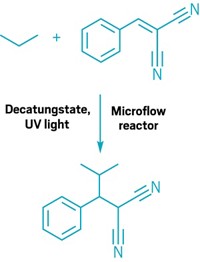Advertisement
Grab your lab coat. Let's get started
Welcome!
Welcome!
Create an account below to get 6 C&EN articles per month, receive newsletters and more - all free.
It seems this is your first time logging in online. Please enter the following information to continue.
As an ACS member you automatically get access to this site. All we need is few more details to create your reading experience.
Not you? Sign in with a different account.
Not you? Sign in with a different account.
ERROR 1
ERROR 1
ERROR 2
ERROR 2
ERROR 2
ERROR 2
ERROR 2
Password and Confirm password must match.
If you have an ACS member number, please enter it here so we can link this account to your membership. (optional)
ERROR 2
ACS values your privacy. By submitting your information, you are gaining access to C&EN and subscribing to our weekly newsletter. We use the information you provide to make your reading experience better, and we will never sell your data to third party members.
C-H Activation
Cerium photocatalysis conquers light hydrocarbon chemistry
Method turns challenging gaseous alkanes into liquid products
by Tien Nguyen
July 29, 2018
| A version of this story appeared in
Volume 96, Issue 31

Reactions that replace carbon-hydrogen bonds with other chemical moieties, called C–H activation reactions, have multiplied in recent years, seemingly spreading to every corner of chemical space. Yet a general method for the activation of light hydrocarbons has hovered just out of chemists’ reach. Because gaseous molecules like methane and ethane are insoluble in most solvents and contain notoriously inert C–H bonds, researchers have resorted to high pressures and temperatures to get the compounds to react with transition-metal catalysts. Now, an approach developed in Zhiwei Zuo’s lab at ShanghaiTech University leverages photocatalysis to promote the C–H functionalization of light alkanes under ambient conditions, except for methane, which required somewhat elevated pressures (Science 2018, DOI: 10.1126/science.aat9750). Using a cheap cerium catalyst and an alcohol hydrogen atom transfer catalyst lit by blue light-emitting diodes, the researchers performed C–H aminations, alkylations, and arylations of light alkanes up to cyclohexane. This work offers an economical way to upgrade feedstock alkanes into commodity compounds, Zuo says, adding that the team is collaborating with experts at Shell to develop additional valuable transformations. The researchers also demonstrated their method in a continuous-flow setup with 10 microreactors, showing that the reaction may be scalable.




Join the conversation
Contact the reporter
Submit a Letter to the Editor for publication
Engage with us on Twitter